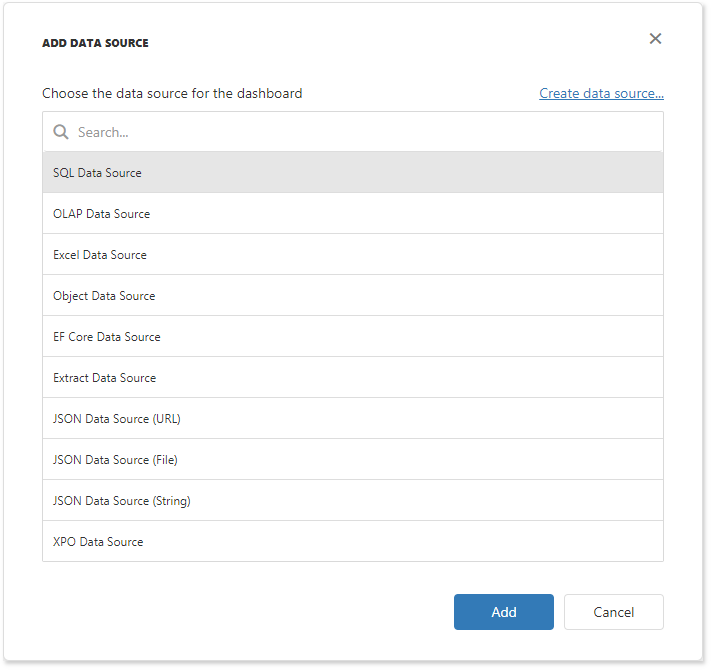Object Data Source
- 2 minutes to read
This tutorial shows how to add the DashboardObjectDataSource to an in-memory data source storage, and make it available to users.
In your application, create the SalesPersonData class and add the following code to it:
public class SalesPersonData { public string SalesPerson { get; set; } public int Quantity { get; set; } public static List<SalesPersonData> CreateData() { List<SalesPersonData> data = new List<SalesPersonData>(); string[] salesPersons = { "Andrew Fuller", "Michael Suyama", "Robert King", "Nancy Davolio", "Margaret Peacock", "Laura Callahan", "Steven Buchanan", "Janet Leverling" }; var rnd = new Random(); for (int i = 0; i < 100; i++) { SalesPersonData record = new SalesPersonData(); record.SalesPerson = salesPersons[rnd.Next(0, salesPersons.Length)]; record.Quantity = rnd.Next(0, 100); data.Add(record); } return data; } }In the Startup.cs file, create a public method that returns the configured dashboard’s data source storage (DataSourceInMemoryStorage) and define the Object data source.
using DevExpress.DashboardCommon; using DevExpress.DataAccess.ObjectBinding; public DataSourceInMemoryStorage CreateDataSourceStorage() { DataSourceInMemoryStorage dataSourceStorage = new DataSourceInMemoryStorage(); DashboardObjectDataSource objDataSource = new DashboardObjectDataSource("Object Data Source"); dataSourceStorage.RegisterDataSource("objectDataSource", objDataSource.SaveToXml()); return dataSourceStorage; }Use the DashboardConfigurator.DataLoading event to supply the dashboard with actual data at runtime.
using DevExpress.AspNetCore; using DevExpress.DashboardAspNetCore; using DevExpress.DashboardWeb; public void ConfigureServices(IServiceCollection services) { services.AddScoped<DashboardConfigurator>((IServiceProvider serviceProvider) => { DashboardConfigurator configurator = new DashboardConfigurator(); // ... configurator.DataLoading += (s, e) => { if(e.DataSourceName == "Object Data Source") { e.Data = SalesPersonData.CreateData(); } }; return configurator; }); }Call the DashboardConfigurator.SetDataSourceStorage method to configure the data source storage. Use the created CreateDataSourceStorage method as the SetDataSourceStorage parameter.
using DevExpress.AspNetCore; using DevExpress.DashboardAspNetCore; using DevExpress.DashboardWeb; public void ConfigureServices(IServiceCollection services) { services.AddMvc(); services.AddScoped<DashboardConfigurator>((IServiceProvider serviceProvider) => { DashboardConfigurator configurator = new DashboardConfigurator(); // ... configurator.SetDataSourceStorage(CreateDataSourceStorage()); return configurator; }); }
The Object Data Source is now available in the Web Dashboard:

Users can now bind dashboard items to data in the Web Dashboard’s UI.
Example
The example shows how to make a set of data sources available for users in the Web Dashboard application.
